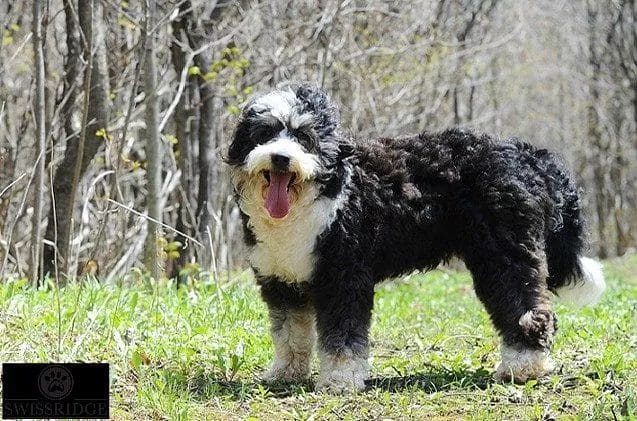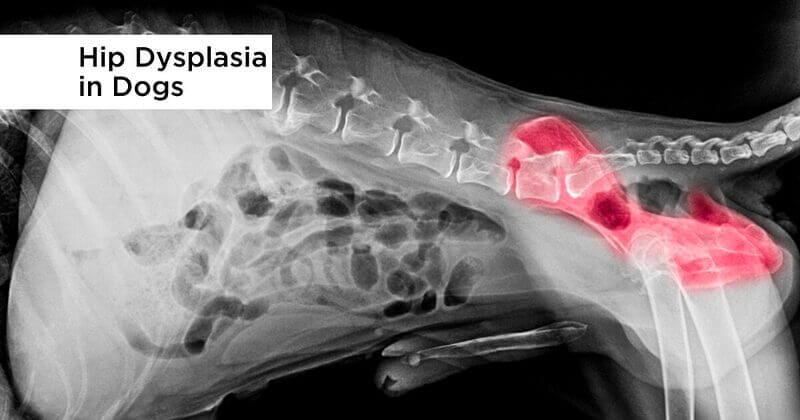Bernedoodle Hip Dysplasia: Everything You Need to Know to Keep Your Furry Friend Happy and Healthy

The bond between a dog and its owner is truly special, as Konrad Lorenz, a renowned animal behaviorist, once said: “The bond with a dog is as pure and deep as any human relationship.” Bernedoodles, with their playful personalities and adorable looks, have captured the hearts of many dog lovers. However, as with any breed, Bernedoodles can be susceptible to certain health concerns, including Bernedoodle hip dysplasia.
This article aims to be a comprehensive guide for Bernedoodle owners, potential owners, and anyone concerned about Bernedoodle hip dysplasia. We’ll explore what Bernedoodle hip dysplasia is, how to identify its signs, available treatment options, and most importantly, preventive measures to keep your furry friend happy and healthy for years to come.
What is Hip Dysplasia?
Hip dysplasia is a malformation of the hip joint, affecting the ball-and-socket joint where the thigh bone (femur) meets the pelvis. In a healthy hip, the ball of the femur fits snugly into the socket of the pelvis. However, in dogs with hip dysplasia, the joint is loose or unstable, causing pain, lameness, and difficulty moving.

Causes of Hip Dysplasia in Dogs
Bernedoodle hip dysplasia can be caused by a combination of factors, including:
- Genetics: Hip dysplasia is a hereditary condition. If a Bernedoodle’s parents have hip dysplasia, the puppy is more likely to develop it.
- Growth Rate: Rapid growth can put extra stress on developing joints, increasing the risk of Bernedoodle hip dysplasia.
- Weight: Overweight dogs put additional strain on their hips, worsening Bernedoodle hip dysplasia.
- Nutrition: A poor diet lacking essential nutrients for joint development can contribute to Bernedoodle hip dysplasia.
- Exercise: Improper exercise or activities that put excessive stress on the hips can also be a risk factor.
Symptoms of Hip Dysplasia in Bernedoodles
Bernedoodle hip dysplasia can manifest in various ways, and the severity of symptoms can vary depending on the stage of the condition. Here are some common signs to watch out for:
- Difficulty rising: Your Bernedoodle may struggle to get up from a sitting or lying position.
- Lameness: Limping on one or both hind legs, especially after exercise.
- Bunny hopping gait: An abnormal hopping gait where both hind legs move together instead of a side-to-side walk.
- Reduced range of motion: Difficulty climbing stairs, jumping, or squatting.
- Pain: Whimpering or yelping when touched around the hips or buttocks.
- Muscle atrophy: Loss of muscle mass in the hind legs.
Diagnosing Hip Dysplasia in Bernedoodles
Early diagnosis of Bernedoodle hip dysplasia is crucial for effective treatment and preventing further joint damage. If you notice any of the signs mentioned above, it’s important to schedule an appointment with your veterinarian.

Importance of Early Diagnosis
Early detection allows for early intervention, which can significantly improve your Bernedoodle’s long-term prognosis. By managing Bernedoodle hip dysplasia early on, you can help minimize pain, maintain joint function, and improve your dog’s quality of life.
Diagnostic Tests
Your veterinarian will conduct a thorough physical examination, including evaluating your Bernedoodle’s gait and range of motion. Depending on the findings, additional diagnostic tests may be recommended, such as:
- X-rays: X-rays can reveal abnormalities in the hip joint structure.
- Hip dysplasia screening tests: These tests, like the PennHip method, can be helpful in detecting Bernedoodle hip dysplasia even in young puppies.
Treatment Options for Bernedoodle Hip Dysplasia
The treatment plan for Bernedoodle hip dysplasia will depend on the severity of the condition and your dog’s age. Here’s an overview of the different approaches:
Conservative Treatments:
- Weight Management: Maintaining a healthy weight is crucial for managing Bernedoodle hip dysplasia. A dog health professional can help you create a weight loss or maintenance plan for your Bernedoodle.
- Exercise Restriction: Limiting strenuous activities that put stress on the hips can help reduce pain and slow down the progression of Bernedoodle hip dysplasia.
- Physical Therapy: Physical therapy exercises can help strengthen the muscles around the hips, improve joint stability, and maintain mobility.
- Dog Training: Proper dog training can help prevent unwanted
- Dietary Support: Providing your Bernedoodle with a high-quality dog food formulated for joint health can be beneficial. These diets often contain glucosamine, chondroitin, and omega-3 fatty acids, which can help support healthy cartilage and reduce inflammation.

Surgical Treatments:
In severe cases of Bernedoodle hip dysplasia, surgery may be recommended to improve your dog’s mobility and alleviate pain. There are different surgical options available, and your veterinarian will discuss the most suitable one for your Bernedoodle based on their individual needs. Some common surgical procedures include:
- Femoral Head Ostectomy (FHO): This surgery removes the head of the femur, allowing the surrounding muscles to form a false joint.
- Triple Pelvic Osteotomy (TPO): This surgery repositions the hip socket to improve joint stability.
Preventing Hip Dysplasia in Bernedoodles
While Bernedoodle hip dysplasia has a genetic component, there are steps you can take to minimize your Bernedoodle’s risk and promote healthy hip development:
Choosing a Reputable Breeder
One of the most important things you can do is choose a reputable Bernedoodle breeder who screens their breeding stock for hip dysplasia. Responsible breeders will have their dogs X-rayed and certified by organizations like the Orthopedic Foundation for Animals (OFA) or the Canine Hip Dysplasia Improvement Registry (CHDI).

Maintaining a Healthy Weight
As mentioned earlier, weight management is crucial for preventing Bernedoodle hip dysplasia. Monitor your Bernedoodle’s weight regularly and consult your veterinarian if they become overweight.
Proper Exercise and Activity Levels
Exercise is essential for your Bernedoodle’s overall health, but it’s important to choose activities that are appropriate for their age and development. Avoid activities that put excessive stress on the hips, such as jumping from high heights or running on hard surfaces.
Nutritional Support for Healthy Hips
Providing your Bernedoodle with a well-balanced diet that includes essential nutrients for joint health can play a significant role in preventing Bernedoodle hip dysplasia. Discuss your Bernedoodle’s dietary needs with your veterinarian and choose a high-quality dog food formulated for large breed puppies or dogs prone to joint problems.
- Early neutering/spaying: Early neutering or spaying in Bernedoodles may influence growth hormone levels and potentially impact hip development. Discuss this with your veterinarian to determine the best timing for your dog.
- Environmental factors: Slippery floors or furniture can increase the risk of falls and injuries that could worsen Bernedoodle hip dysplasia. Consider providing your dog with non-slip mats or rugs to improve their footing.
Living with a Bernedoodle with Hip Dysplasia
If your Bernedoodle has been diagnosed with Bernedoodle hip dysplasia, there are still ways to ensure they have a happy and fulfilling life. Here are some tips:

Providing Pain Management:
Your veterinarian can prescribe pain medication or recommend alternative therapies like acupuncture or massage to help manage your Bernedoodle’s discomfort.
Supportive Equipment:Using supportive equipment like ramps or harnesses can help your Bernedoodle get around more easily and reduce strain on their hips.
Maintaining Quality of LifeFocus on activities that your Bernedoodle can still enjoy. Dog training can be a great way to provide mental stimulation and bonding opportunities, even with limitations due to Bernedoodle hip dysplasia. Explore low-impact activities like swimming or short walks on soft surfaces.
Finding the Right Veterinarian
Choosing the right veterinarian is crucial for ensuring your Bernedoodle health receives the best possible care. Here are some reputable veterinary associations in the US that can help you locate qualified professionals in your area:
- The American Veterinary Medical Association (AVMA): https://www.avma.org/
- The American Animal Hospital Association (AAHA): https://www.aaha.org/
Conclusion: A Happy and Healthy Life for Your Bernedoodle
Bernedoodle hip dysplasia can be a concern, but with proper care and management, your Bernedoodle can still live a long and happy life. By understanding the condition, taking preventive measures, and seeking veterinary guidance when needed, you can ensure your furry friend thrives for years to come.
1. Can hip dysplasia be prevented in Bernedoodles?
While there’s no guaranteed way to prevent Bernedoodle hip dysplasia, choosing a reputable breeder, maintaining a healthy weight, providing proper exercise and nutrition, and avoiding certain activities can significantly reduce the risk.
2. What are the treatment options for Bernedoodle hip dysplasia?
Treatment options for Bernedoodle hip dysplasia depend on the severity and can include conservative management like weight control, exercise restriction, physical therapy, and dietary support. In severe cases, surgery may be recommended.
3. What is the best food for Bernedoodles prone to hip dysplasia?
There’s no single “best” food for Bernedoodles prone to hip dysplasia, but choosing a high-quality dog food formulated for large breeds or joint health is crucial. Look for a diet rich in glucosamine, chondroitin, and omega-3 fatty acids, as these nutrients can support healthy cartilage and reduce inflammation. Discuss your Bernedoodle’s specific needs with your veterinarian for a personalized dietary recommendation.
4. Should I get pet insurance for my Bernedoodle?
Pet insurance can be a valuable tool for managing veterinary costs, especially if your Bernedoodle develops a condition like Bernedoodle hip dysplasia. Consider pet insurance plans that cover orthopedic conditions and discuss your options with a reputable pet insurance company.
Famous Veterinary Center for Bernedoodle Hip Dysplasia:
The Angell Animal Medical Center in Boston, Massachusetts, is a renowned veterinary center with specialists experienced in treating Bernedoodle hip dysplasia and other orthopedic conditions in dogs. They offer advanced diagnostic techniques, surgical procedures, and rehabilitation services. It’s important to note that this is just one example, and many other veterinary centers across the US specialize in treating Bernedoodle hip dysplasia.
Remember: Early diagnosis and intervention are key to managing Bernedoodle hip dysplasia effectively. By staying informed, taking preventative measures, and working closely with your veterinarian, you can ensure your beloved Bernedoodle enjoys a long and happy life filled with tail wags and zoomies.
Petscaretip – How To Care Your Pets
Address: 809 Dallas St, Houston, TX 77002, USA, Houston, TX, United States, Texas
Email: [email protected]










